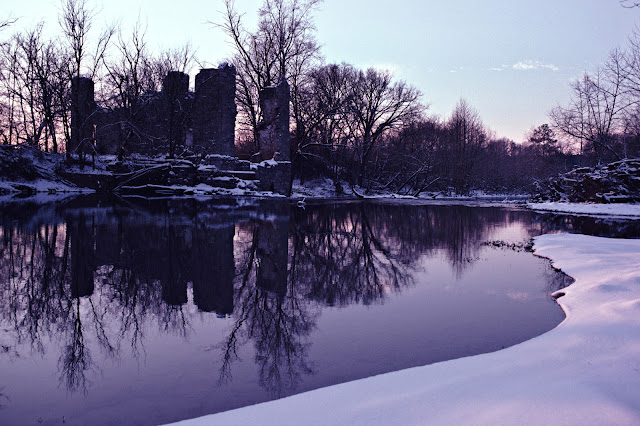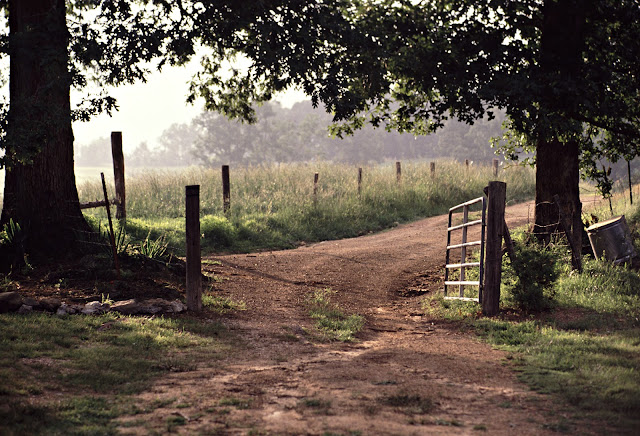
Horse Laugh, U.S. Hwy. 11, McMinn County, Tennessee. (RCB-TN-41)
Blog Note:
This is Part two of the birth story of the Rock City Barns book. The two parts were originally published as one article in the May, 1999 issue of Rangefinder Magazine.
Sorting Rock City's old file cards by states and within states by highways, I planned
an itinerary for my first trip and began photographing at Sweetwater,
Tennessee on October 24,
1994. Over the next 18 months, stealing
time whenever my studio schedule allowed, the trail of barns led my old Chevy
Blazer nearly 35,000 miles to more than 500 sites in 15 Southeastern and
Midwestern states. Nearly 250 barns were
found in 14 states, with only Michigan
proving barren.
With
35-year-old, often sketchy records and occasional hearsay reports as my only
sources of information, finding the sites was an endlessly fascinating piece of
detective work. Barns have burned, blown
down, been bulldozed for highway construction and subdivisions, or simply
fallen from disuse and disrepair. Many of
the largest and finest are gone. To complicate things still further, highways
have been changed, re-routed, and re-named.
Often,
the only way to locate a site was to find someone who remembered the property
owner:
"Do
you remember so-and-so, who had a place out on Highway 11 south of here?"
"Oh,
yeah, knew him well. He and my daddy
used to go fishin' together all the time.
Good ol' feller. He's dead
now."
"Well,
he had this barn on his farm, with a sign that said 'See Rock City.'
Here's an old picture of it."
"Sure,
I remember that ol' barn. Fact is, I
helped him take it down, back around 1985.
It had got all rotten and falling down, y'know. Weren't safe."
I
also learned to take the information I was given with a grain of salt. The people most familiar with an area are
often the least observant. In Robbinsville, North
Carolina I asked a gas station attendant about a
barn. "Oh, sure," he said,
"It was just down the road here, about a half mile. But it's been torn down." Checking for myself, I found his directions
to the site were perfect. But not only
was the barn still standing, it had just been repainted and was one of the rare
barns with "See
Rock City"
signs on both sides!
In
those pre-digital days, of course, everything was photographed on film, mostly
Fujichrome 100. I began the project with a pair of Canon EOS-10S bodies and one
EOS-RT and gradually upgraded my equipment so that by the time I finished I was
working with two Canon A2s and a 10S.
Lenses carried were the 70-210mm f4, the 28-105mm f3.5-4.5, the 50mm
f1.8, the 35mm f2, and the 24mm f2.8, all Canon EF. Probably 90% of the photographs were made
with the 24 and the 28-105. Exposures
were almost always read with a Minolta Flashmeter III in incident mode. Color
filters were used frequently to render scenes the way I felt them.
Each
barn was also photographed in black and white. (Pre-digital days, remember?)
An
average day of photography might involve driving more than 450 miles in 12 to
15 hours, and result in locating eight or ten sites, of which three to
five might have barns. Some days were
better than that, of course, and some were much worse. I spent a total of about 75 days on the
assignment, capturing images in winter snow, summer haze, the soft light of
spring and the clear light of autumn. Working the sweet early and late light in
midsummer meant 18-hour days and not much sleep.
I
began the project with some idealism, I suppose. Expecting to find prosperous,
story-book farmyards, I often found depressing scenes of rural desolation. Most of the barns were far from any
farmhouse. Many were dilapidated, some
were overgrown with brush. I learned to
take whatever each situation gave me and tried to use that to make a photograph
which expressed the spirit of the place
What
began as the assignment of a lifetime grew into a labor of love as I came to
treasure the dignity and individuality of each old barn. I learned to see beauty even in the isolation
in which so many of them are ending their days.
I learned that they wanted to be photographed in a direct, documentary
way, without artifice. They seemed to
say, "Here we are. This is the
way we are. Please let us speak for
ourselves."
(Canon EOS 10S. 24mm f2.8 Canon EF lens. Fujichrome
100 film.)
If you like my photographs, you can see more of them in my online gallery at https://davejenkins.pixels.com/ Looking is free, and, who knows? You might find something you want to keep.
The second edition of my book, Backroads and Byways of Georgia
will be released in June, 2023.
Photograph and text copyright 2023 David
B.Jenkins.
I post Monday, Wednesday, and Friday unless
life gets in the way.
Soli Gloria Deo -- For the glory of God alone.

















